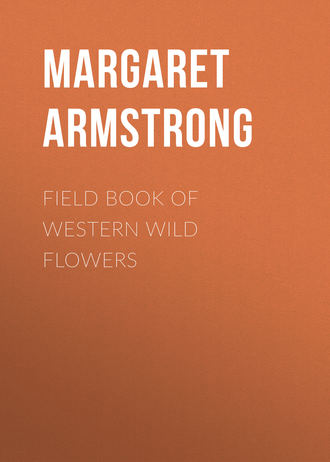 полная версия
полная версияField Book of Western Wild Flowers

Scarlet Gilia – G. aggregata.
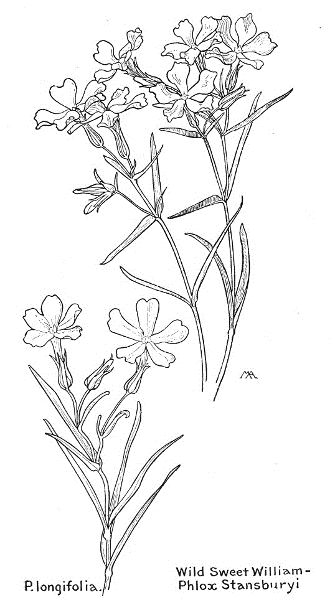
P. longifolia.
Wild Sweet William – Phlox Stansburyi.
Bird's Eyes
Gília trìcolor
White and purple and yellow
Spring
Southwest
A beautiful kind, with rather hairy, branching stems, from six inches to over a foot tall, and dull green, rather hairy leaves, prettily cut into long narrow lobes. The flowers are in clusters, sweet-scented and beautifully marked, with corollas a half-inch or more in length, open funnel-shaped, with a yellow tube marked by a white border, and two dark purple spots in the throat below each of the blue or whitish corolla-lobes, forming an "eye." The calyx lobes often have purple margins, the anthers are bright blue, with lilac filaments, and the pistil is lilac. This is common on low hills in western California.
Blue Desert Gilia
Gília rigídula
Blue
Summer
Arizona
A strange little desert plant, stunted-looking but with brilliant flowers, forming low, prickly clumps of stiff, dry, dull green, needle-like foliage, suggesting cushions of harsh moss, with numerous woody stems, two or three inches high, and numbers of pretty flowers, half an inch across, deep bright blue, with a little yellow in the center; the stamens, with bright yellow anthers, projecting from the throat. This bravely opens its bright blue eyes in the desert wastes of the Petrified Forest.
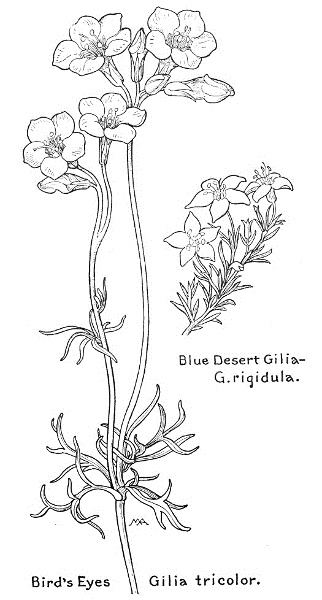
Blue Desert Gilia – G. rigidula.
Bird's Eye – Gilia tricolor.
Downy Gilia
Gília floccòsa
Blue
Spring
Southwest
A little desert plant, about three inches tall, more or less downy all over, the upper leaves and buds covered with soft white down and the lower leaves dark green and stiff, tipped with a bristle. The tiny flowers have a blue corolla, varying from sky-blue to almost white, with a yellow throat and white stamens, and although they are too small to be conspicuous, the effect of the bits of blue on the desert sand is exceedingly pretty.
Small Prickly Gilia
Gília púngens
White
Summer
California
This resembles Alpine Phlox in general effect, but the corolla is funnel-form instead of salver-form, for the lobes do not spread so abruptly. The many stems are woody below, a few inches high, and crowded with leaves, which are dull green, stiff, and cut into needle-like divisions, which look like single leaves, about half an inch long. The flowers are pretty and fragrant, half an inch across, white or pale pink, often with purplish streaks on the outside, with rounded lobes, the edge of each overlapping the next, and yellow anthers, not projecting from the throat of the corolla. This forms loose mats on rocky ledges, at high altitudes.
Gília multicàulis
Lilac
Spring
California
A rather pretty little plant, about eight inches tall, with several slender, slightly hairy stems and leaves cut into very narrow divisions. The little flowers are pale lilac, quite delicate and pretty, though not conspicuous, and form clusters at the tips of the branches. This sometimes grows in quantities in the hills of southern California and is variable.
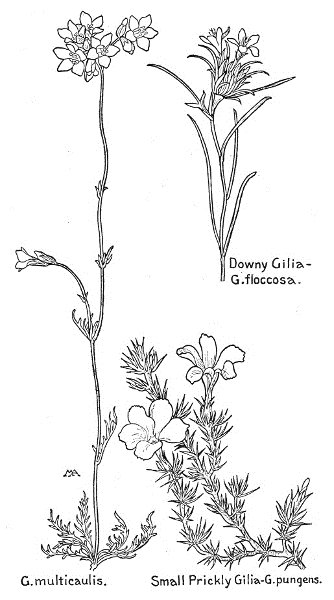
Downy Gilia – G. floccosa.
G. multicaulis.
Small Prickly Gilia – G. pungens.
Large Prickly Gilia
Gília Califórnica
Pink
Summer
California
An unusual-looking, conspicuous, shrubby plant, suggesting some kind of small prickly pine or cedar, with lovely flowers. It forms large straggling clumps, about two feet high, with many woody stems and rich-green foliage, the leaves cut into small, spreading, needle-like lobes, and ornamented with numbers of brilliant flowers. They are an inch or more across, with bright pink petals and a white "eye," and are most delicate in texture, with a satiny sheen and smelling sweet like violets. This grows on hills and is very beautiful on Mt. Lowe.
Gília achillaefòlia
Blue, white
Spring, summer
California
This varies a good deal in color and beauty. The stems are smooth and slender, from one to two feet tall, and the leaves are alternate, smooth or downy, delicately cut into many fine divisions. The numerous small flowers are funnel-form, with projecting stamens, and form a close round head, which is an inch or more across, without bracts. The calyx is more or less woolly, with sharp triangular teeth, the tips turned back. Usually the flowers are blue of some shade, deep or pale, sometimes forming patches of color in the fields, but the prettiest I have seen grew in the woods near Santa Barbara, the individual flowers larger than usual and pure white, with bright blue anthers. It is common in Yosemite, but rather dull bluish-white and not pretty.
Gília capitàta
Blue
Spring, summer
Northwest and California
Very much like the last, but the flowers are smaller and form a smaller, more compact head. The corollas are blue, with narrow petals, varying in tint from purplish-blue to pale lilac, the calyx not woolly, and the cluster is about an inch across, the stamens giving it a fuzzy appearance. The leaves are smooth or slightly downy and the seed-vessels form pretty pale green heads. This is common and sometimes grows in such quantities as to be very effective.
Gília multiflòra
Blue
Summer
Ariz., New Mex.
The general effect of this plant is inconspicuous, though the flowers are quite pretty close by. The roughish woody stem is only a few inches tall and then branches abruptly into several long sprays, clothed with many very small, narrow, pointed, thickish, dull green leaves and ornamented towards the end with small clusters of flowers, which are lilac or blue, marked with purple lines, less than half an inch across, with five irregular lobes and blue anthers. This grows at the Grand Canyon and in dry open places in the mountains.
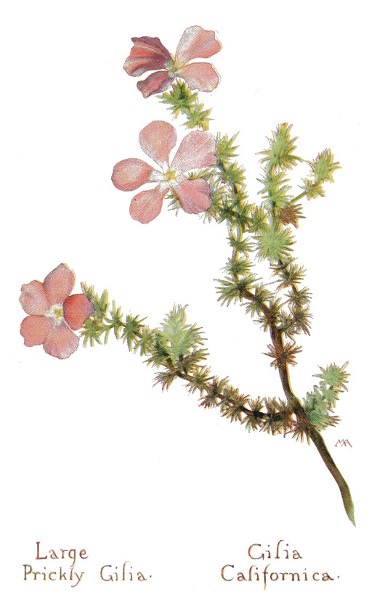
Large Prickly Gilia – Gilia Californica.
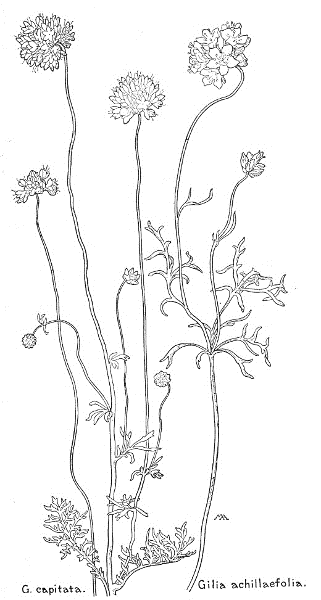
G. capitata.
Gilia achillaefolia.
There are several kinds of Collomia, almost all annuals; leaves alternate, usually toothless; flowers in clusters; differing from Gilia and Linanthus in the calyx, which increases in size as it grows older; corolla tube-shaped, funnel-form, or salver-form, with spreading lobes; stamens unequally inserted on the corolla-tube, with unequal filaments; seeds usually mucilaginous.
Collòmia grandiflòra (Gilia)
Buff
Summer
Cal., Utah, Wash.
Very pretty flowers, which attract attention because of their unusual coloring. The leafy stem is from one to two feet tall and slightly downy and the leaves are generally toothless, smooth, and rather dark green. The flowers form a roundish terminal cluster, which is about two inches across, surrounded by broad bracts, which are sticky to the touch. The corolla is funnel-form, about an inch long, various shades of buff or salmon-color, and as the downy buds are yellow, the newly-opened flowers buff, and the older ones pinkish or cream-white, the combinations of color are odd and effective. This is quite common in Yosemite, in warm situations, and much cultivated in Germany. It is sometimes called Wild Bouvardia, but this is a poor name, as it is that of a plant belonging to an entirely different family.
Collòmia lineàris (Gilia)
Pink
Summer
West
From six inches to over a foot tall, with a rather stout, very leafy stem, more or less branching, and alternate leaves, smooth, toothless, and rather dark green, the upper stems and buds hairy and sticky. The flowers have no pedicels and narrow funnel-form or salver-form corollas, bright pink, about a quarter of an inch across, and are crowded in roundish clusters, at the tips of the leafy branches, the larger clusters toward the top. Though the tiny flowers are bright and pretty this is not an effective plant. It grows in dry, open, sandy places and the foliage has a rather disagreeable smell when crushed.
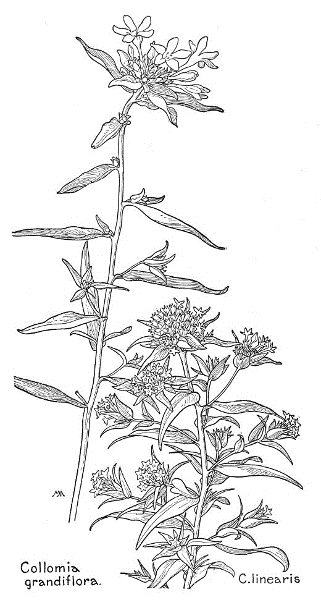
Collomia grandiflora.
C. linearis.
WATERLEAF FAMILY. Hydrophyllaceae
Herbs or shrubs, mostly natives of western North America; often hairy; with no stipules; the leaves mainly alternate or from the root; the flowers chiefly blue or white, often in coiled clusters; the calyx with five united sepals; the corolla with five united petals; the stamens five, on the base of the corolla and alternate with its lobes, with threadlike filaments and usually with swinging anthers; the ovary superior, the styles two or two-cleft; the fruit a capsule, containing few or many seeds. The leaves were formerly supposed to have water-cavities in them, hence the misleading name. Some of this family resemble some of the Borages, but the stamens are long, the styles are two, at least above, and the ovary has not the four conspicuous lobes of the latter family.
There are many kinds of Phacelia, hairy plants, with no appendages between the sepals; resembling Hydrophyllum, except that the petals overlap in the bud, instead of being rolled up, and the seeds are different. The name is from the Greek, meaning "cluster."
Phacelia
Phacèlia lóngipes
Purple
Spring
California
This has pretty and rather unusual looking foliage, for the leaves are a peculiar shade of bluish-green, with purplish margins. They are somewhat sticky, soft and velvety, and although hairy are not disagreeable to touch. The hairy, purplish stems grow from a few inches to a foot tall and the pretty flowers are lilac or purple, with yellow anthers, and measure three-quarters of an inch across. This grows on sunny, sandy mountain slopes.
Phacelia
Phacèlia glechomaefòlia
Lilac, white
Summer
Ariz., Utah, Cal.
A low plant, partly creeping, with weak, brittle, sticky stems and soft, slightly thickish, very dull yellowish-green leaves, sticky and often dingy with dust. The flowers are usually violet, but sometimes pure white, about three-eighths of an inch across, with yellow stamens, and are rather pretty. I found this little plant growing under a huge red rock in the Grand Canyon, on apparently perfectly dry, bare soil. It has an aromatic and slightly unpleasant smell and is rare.
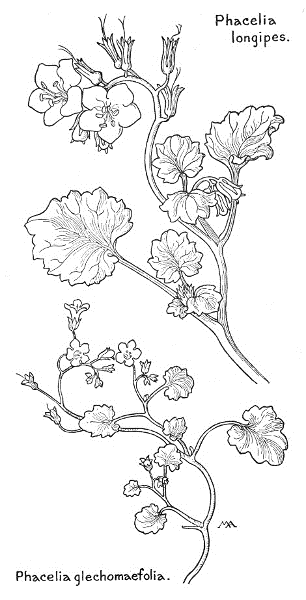
Phacelia longipes.
Phacelia glechomaefolia.

Phacelia
Phacèlia serícea
Purple
Summer
Northwest, Nev., Utah
A mountain plant, which in favorable situations is exceedingly handsome and conspicuous, about a foot tall, but sometimes more, with downy, leafy stems, and handsome, silky-downy foliage, cut into many narrow divisions. The bell-shaped flowers are three-eighths of an inch across, rich purple, with very long, purple filaments and yellow anthers, and are crowded in magnificent clusters, sometimes eight inches long and very feathery. The corolla dries up and remains on the fruit. This has a disagreeable smell and grows at very high altitudes, where it is unusual to find such large showy flowers. In dry unfavorable situations it is often small and pale in color.
Phacelia
Phacèlia Párryi
Purple
Spring
California
This has very handsome flowers, but the plant is too straggling. The branching, reddish stems are very hairy and rather sticky, from one to nearly two feet tall, with dull green, hairy leaves, which are harsh but not disagreeable to touch, and the flowers are over three-quarters of an inch across, with a very hairy calyx and a bright purple corolla, with a cream-colored spot, the shape of a horseshoe, at the base of each petal. The filaments are purple and hairy, with cream-colored anthers and the style is white, tipped with purple. This sometimes grows in such quantities as to give a very brilliant color effect and is found from Los Angeles to San Diego.
Vervenia
Phacèlia dístans
Violet
Spring
Southwest
This is from eight inches to two feet high, with hairy, soft, dull green leaves and hairy stems, which are usually branching and spreading. The flowers are less than half an inch across, with a very hairy, sticky calyx, a violet corolla, varying in tint from dull white to bright blue, fading to purple, and purple filaments with whitish anthers. This grows in dry places and is common, often forming large clumps covered with flowers which are quite effective in color, though the plants are too straggling and hairy to be very attractive close by. P. ramosíssima is similar but coarser, the flowers are larger, and the plant is exceedingly hairy, the calyxes being covered with conspicuous, long, white hairs, and the whole plant unpleasant to touch.

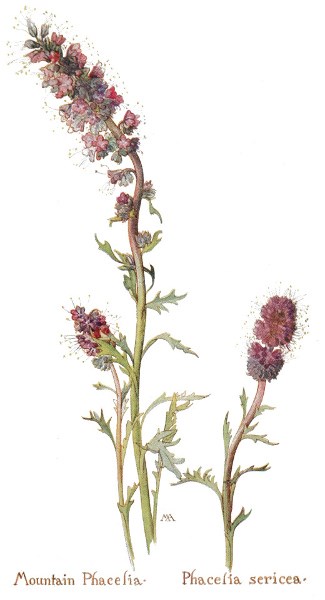
Mountain Phacelia – Phacelia sericea.
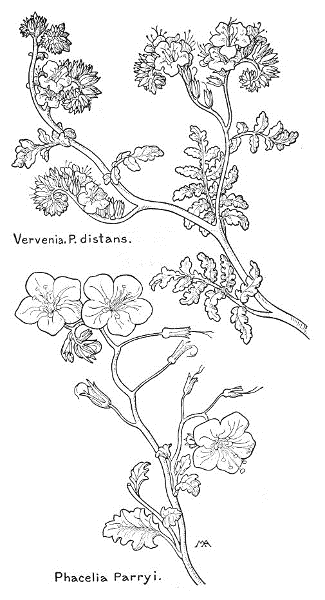
Vervenia. P. distans.
Phacelia Parryi.

Phacelia
Phacèlia Fremóntii
Purple
Spring
Southwest and Utah
A charming little desert plant, four or five inches high, with one or more, purplish, branching stems, springing from a pretty cluster of thickish, dull green root-leaves. The flowers are half an inch across, with sticky, hairy calyxes and buds and bright purple corollas, with bright yellow throats, from which the stamens do not protrude. These little flowers look very gay and pretty against the desert sand.
Phacelia
Phacèlia lineàris
Purple
Spring, summer
Northwest and Utah
This is a delicate and pretty plant, in spite of its hairy foliage, from six inches to a foot high, with a hairy stem, purplish and somewhat branching, and alternate leaves, which are sometimes deeply cleft, usually have no leaf-stalks and are hairy and light yellowish-green in color. The flowers are pretty, grouped in rather long clusters, and are each about half an inch across, with a hairy calyx and a corolla delicately tinted with various shades of clear lilac and blue, shading to white in the center, with long narrow appendages in the throat between the stamens, which are long and conspicuous, giving a feathery appearance to the cluster. The anthers are dark purple and mature before the stigma, and the buds are pink and white. This grows on dry hillsides, often under sage-brush.

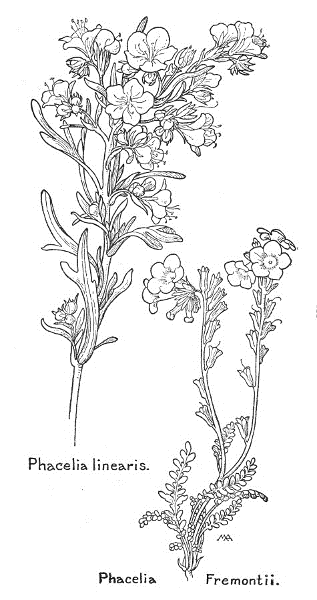
Phacelia linearis.
Phacelia Fremontii.

Phacelia
Phacèlia grandiflòra
Lilac
Summer
California
A very handsome kind, though rather coarse, and hairy and sticky all over, but with lovely, delicate flowers. The stems are from one to three feet tall and the dark green leaves are velvety on the upper side and hairy on the under. The flowers often measure two inches across, with a lilac or mauve corolla, shading to white in the center, flecked and streaked with brown, blue, or purple, and the stamens have purple filaments and pale yellow anthers. This plant is unpleasantly sticky, with a viscid fluid which stains everything with which it comes in contact, is poisonous to some people, and is found from Santa Barbara to San Diego.
Phacèlia víscida var. albiflòra
White
Spring
California
This is a white variety, with pretty, delicate white flowers. Phacelia viscida is very much like P. grandiflora, and has about the same range, but is not so large a plant, usually about a foot tall, with smaller flowers, about an inch across. The corollas are blue, with purple or white centers.
Wild Canterbury-bell
Phacèlia Whitlàvia
Purple
Summer
California
Charming flowers, though the foliage is rather too hairy. The stout, reddish stems are hairy, brittle, and loosely branching, about a foot tall, and the leaves dull green and hairy. The handsome flowers are in graceful nodding clusters, with a bell-shaped corolla, about an inch long, a rich shade of bluish-purple, the long conspicuous stamens and pistils giving an airy look to the blossoms. The filaments are purple and the anthers almost white and, as in other Phacelias, when the corolla drops off the long forked style remains sticking out of the calyx like a thread. This grows in light shade in rich moist soil in the hills.


Phacelia grandiflora.
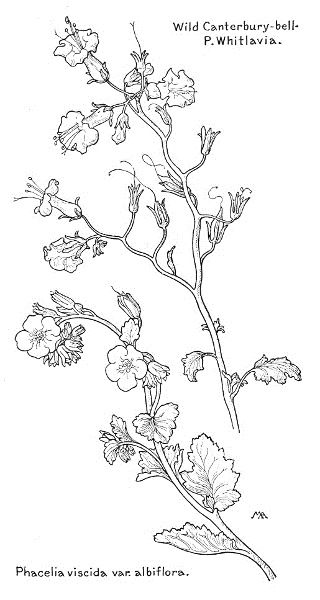
Wild Canterbury-bell – P. Whitlavia.
Phacelia viscida var. albiflora.
Alpine Phacelia
Phacèlia alpìna
Lilac
Summer
Utah, Nev., etc.
This just misses being a very pretty plant, for the leaves are attractive, but the flowers are too small and too dull in color for the general effect to be good. The stems are about ten inches tall, purplish and downy, and the leaves are dull green and rather downy, with conspicuous veins. The buds are hairy and the flowers are lilac and crowded in coiled clusters, to which the long stamens give a very feathery appearance. This is found in the mountains, as far east as Montana and Colorado, and reaches an altitude of over twelve thousand feet.
Wild Heliotrope
Phacèlia crenulàta
Lilac
Spring
Arizona
This is a fine plant, from six to eighteen inches tall, with purplish stems and handsome coarse foliage, all rough, hairy, and very sticky. The flowers are lilac, with purple stamens and pistil, and the general effect is that of a large coarse Heliotrope. The flowers have a pleasant scent, but the foliage has a strong and disagreeable smell, and it grows on the plateau in the Grand Canyon.
Arizona Phacelia
Phacèlia Arizònica
White, mauve
Spring
Arizona
A little desert plant, not very pretty, with several hairy flower-stalks, from three to six inches tall, springing from a rosette of soft thickish leaves, slightly hairy, dull green in color, and something the shape of the leaves of P. Fremontii, but the lobes not nearly so small. The flowers are in tightly coiled clusters; the corolla a little more than a quarter of an inch across, dull white, with a pinkish line on each lobe and lilac anthers, the general effect being mauve.
There are a good many kinds of Nemophila, natives of North America, mostly Californian, slender, fragile herbs, with alternate or opposite leaves, more or less divided, and usually large, single flowers, with rather long flower-stalks. The calyx has an appendage, resembling an extra little sepal, between each of the five sepals, which makes these plants easy to recognize, and the corolla is wheel-shaped or bell-shaped, usually with ten, small appendages within, at the base, and the petals are rolled up in the bud; the stamens are short; the styles partly united. The name is from the Greek, meaning "grove lover," because these plants like the shade.
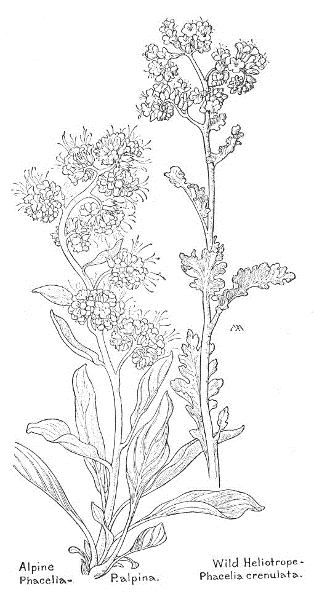
Alpine Phacelia – P. alpina.
Wild Heliotrope – Phacelia crenulata.

Baby Blue-eyes, Mariana
Nemóphila insígnis
Blue and white
Spring
California
These are exceedingly charming little plants, with slender, weak, hairy stems, varying a good deal in height, but usually low and spreading, and pretty, light green, soft, hairy foliage, sprinkled with many lovely flowers, an inch or more across, with hairy calyxes and sky-blue corollas, which are clear white in the center and more or less specked with brown, with ten hairy scales in the throat. The blue of their bright little faces is always wonderfully brilliant, but they are variable and are usually deeper in color and rather smaller in the South. This is one of the commonest kinds of Nemophila in California and it is a general favorite. It is called Mariana by the Spanish Californians.
Baby Blue-eyes
Nemóphila intermèdia
Blue and white
Summer
California
This is much like the last, but it is a taller and more slender plant, usually about ten inches high. The lovely delicate flowers are less than an inch across, with light blue corollas, usually shading to white at the center and delicately veined with blue, or speckled with purple dots. This grows among the underbrush.
Spotted Nemophila
Nemóphila maculàta
White and purple
Summer
California
These are charming flowers, their corollas oddly and prettily marked. The weak, hairy stems, from three to twelve inches long, are usually spreading and the leaves are opposite, hairy, and light green. The flowers are about an inch across, with hairy calyxes and white corollas, which are prettily dotted with purple and usually have a distinct indigo spot at the tip of each petal, which gives an unusual effect. The filaments are lilac and the anthers and pistil are whitish. This is common in meadows around Yosemite and in other places in the Sierras at moderate altitudes.

